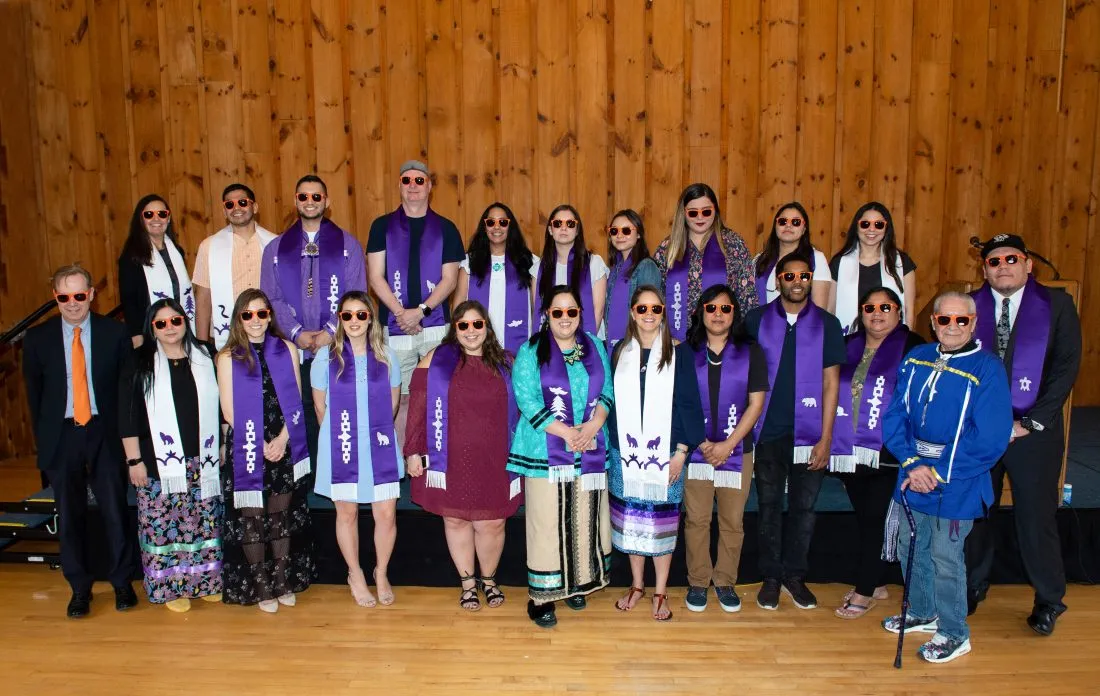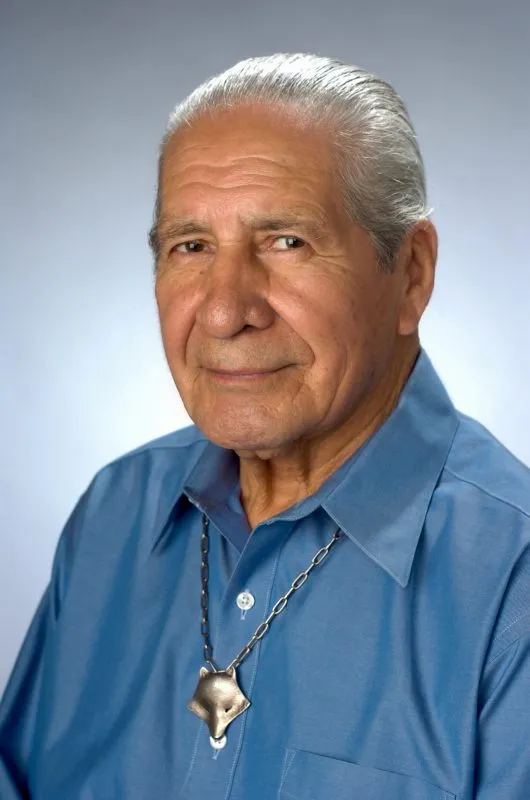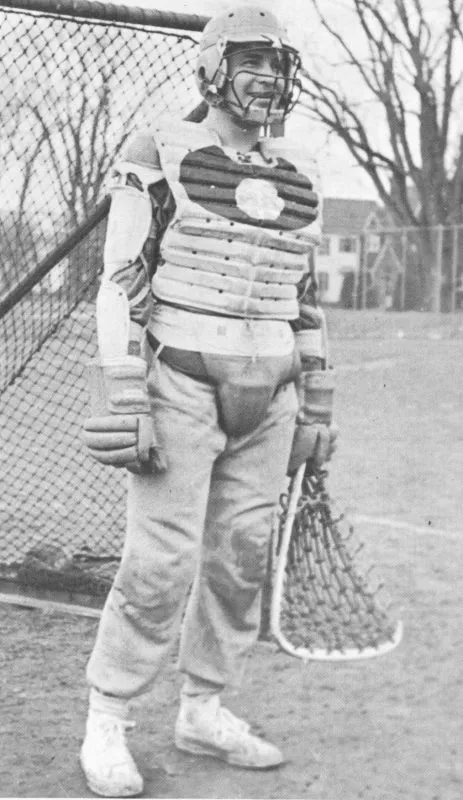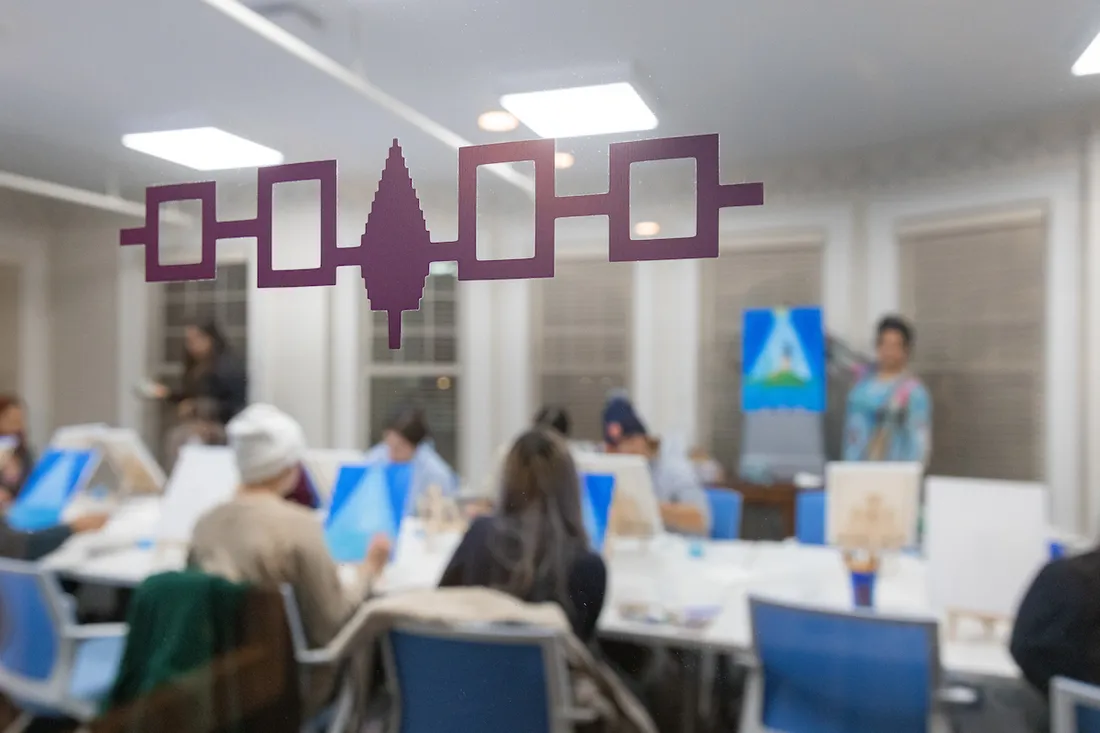
Oren Lyons (lower right) attended a reception for the Indigenous graduates of Syracuse University’s Class of 2018.
Oren Lyons ’58, H’93 turned 90 this year, but he doesn’t spend a lot of time looking back on his remarkable life. Instead, his focus is on fulfilling his obligation to the seven generations to come, a Haudenosaunee promise that requires him to act in good faith now to leave a peaceful and healthy planet for all life.

Oren Lyons ’58, H’93, Faithkeeper of the Turtle Clan of the Onondaga Nation.
As a Faithkeeper—one of the spiritual leaders of the Turtle Clan of the Onondaga Nation—Lyons has been an eloquent activist for environmental protections and the rights of Indigenous people. His voice has been heard at the United Nations and at international summits in London, Moscow, Tokyo, Brazil and South Africa. He’s convened with governmental and spiritual leaders like Mikhail Gorbachev, Mother Teresa, Al Gore and the Dalai Lama. He delivered the eulogy at Muhammad Ali’s funeral and made a global warming documentary with Leonardo DiCaprio. “I’m an ordinary guy,” he says, “but I work in regional, national and international arenas. It is important to bring the Indigenous voice and perspective into these discussions."
Lyons is also one of the first Native Americans to have attended Syracuse University, where he earned a degree in fine arts from the College of Arts and Sciences and distinguished himself as an artist and an athlete. He remains one of the most talented lacrosse players in University history.
The Medicine Game
Lacrosse was a ceremonial game Lyons learned on the Onondaga Nation near Syracuse, where he grew up with seven siblings. “The game is part of our upbringing,” he explains. “There is the secular game we all enjoy and there is the medicine game. Any one of our people can call for a game for health reasons. This is a community event—the men and women of the society take charge. On game day all players, old and young, gather with their hickory sticks—no plastic is allowed in this game. The hickory and leather represent and invoke all elements of the natural world.”

Oren Lyons was an All-American goalie who led the 1957 Syracuse University lacrosse team to an undefeated season.
The game opens with a ceremony, Lyons explains, and then is played in the original way, with two goals, no boundaries, no pads, no referees, and all players on the field at the same time. It ends when an agreed-upon number of goals is reached. “The game is played in a high spirit,” he says. The ball is made that day, and at the end of the game there is special food for all participants and a ceremonial closing, when the ball is given to the one who called for the game.
“In the spring, the first medicine game is played for all who will pick up the stick that year,” Lyons says. “It’s old style, with a lot of excitement and fun—a game I have played into my eighties. The essence of that spirit carries over into the secular game. That’s what players feel when they pick up the stick,” he believes.
The medicine game is very different from the secular lacrosse Lyons played for Coach Roy Simmons Sr. at Syracuse University. “In the 1940s, Coach Simmons would come down to the Nation and ask us to come up and scrimmage with the Syracuse University lacrosse team. ‘I want the boys up there to see what stick handling really looks like,’ he’d say. So we’d go up to the University, our ragtag team, and we’d beat them,” Lyons says. “It was fun, and there was always a good meal there.”
Navigating a New Path
In 1953, Simmons asked him if he would ever consider playing for the University. “I was 24 years old and I’d been in the Army, but I had quit school in the seventh grade,” Lyons recalls. “I told him I didn’t have the background. He pointed out that I was a good painter, and since I’d been in the service I had probably taken the Army equivalency test.”
“So we went up to see the dean of admissions, Dean Hefner, and he said, ‘You were in the service?’
“I said, ‘Yes, sir.’
“‘What branch?’
“‘I was in the 82nd Airborne, 504 Regiment. I was a jumper.’
“And he said, ‘That’s my command.’
“I remember Coach Simmons taking his pipe out and lighting it. He said ‘Your records are scattered, but your artwork is equal to anything here. You’re obviously an accomplished artist. Let’s start looking for your records.’”
“So that’s how I started,” Lyons says. “It was a huge struggle. You had to take English, and I almost had a nervous breakdown trying to catch up. But I had a lot of help. All my other classes were art classes, and I made the Dean’s List that first semester. But English—that was rough.”
Lacrosse came much easier to him, and he became a standout All-American goalie who led the 1957 team to its first undefeated season since 1924. “It was great,” he recalls. “I was just super lucky to go to Syracuse University.” The University, which is built on Haudenosaunee ancestral land, now has a number of scholarships for Native American students .
Embracing Art and Culture
After graduating with a bachelor’s degree in fine arts, Lyons enjoyed a successful career as an artist in New York City. “I think we all have art in us, and in Native nations, you can’t separate it from our culture,” he says. “It’s the idea of creating and creation. Everything we did was very beautiful. Look at the lacrosse sticks and cradleboards. Look at the outfits and the beadwork. Look at the design of the bowls and the spoons. It was intrinsic, so art wasn’t something you hung on a wall. It was in your everyday life, like prayer.”
I think we all have art in us, and in Native nations, you can’t separate it from our culture.
Oren Lyons
After Lyons graduated, many other accomplishments followed. He became a renowned publisher of Native American literature. He co-founded the Native American Studies department at the University at Buffalo, where he is now a distinguished service professor emeritus. He delivered the Commencement address at Syracuse University in 1993 and was awarded an honorary Doctor of Laws degree.
In 1983, he co-founded the Iroquois Nationals, a team that represents the Haudenosaunee in international field lacrosse competition. They are currently ranked third in the world in the men’s field game and second in the indoor box game.
Regeneration for New Generations
Lyons continues to advocate for the welfare of future generations, insisting that if we don’t act now, there may not be any future generations. “Old age gives you perspective, and the older you get, you realize how little you know,” he says. But there are a few things he’s sure about. “Right now, you’re dealing with a political situation in the United States that is critical. But that’s a local situation, whereas global warming is an existential threat to life itself, to humanity. People think of themselves as the central force in the universe, but actually we’re like fleas on a dog,” he points out.
“The earth is not going to disappear,” Lyons asserts. “It has great regenerative powers. One of my good friends was the late John Mohawk—I call him the resident intellect of the Iroquois. Mohawk said, ‘Well, as far as I can see, human beings are still a biological experiment. We’re here a short time, and the Earth is not dependent on us—we are dependent on it. In time it will regenerate and all the lakes and rivers will again be pristine. All life will be green again. It will be peaceful. There may not be people, but the Earth will regenerate. The Earth has all the time in the world.’”


